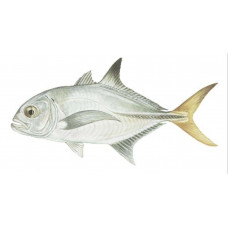Latin name
Caranx latus
Other names
Big-eye jack, goggle-eye, horse-eye trevally; French: carange moyole; Portuguese: guarajuba; Spanish: jurel, jurel ojo gordo, ojón, xurel.
Identification
The horse-eye is silvery, with yellow caudal fins and usually darker edges on the dorsal and upper caudal fin. It often has a small black spot on the upper end of the gill cover, and normally has blackish scales. The body is compressed, and the entire thorax is covered with scales. The dorsal fin has 20-22 soft rays, and the lower extremity of the first arch has 14-18 gill rakers. It is similar in shape to crevalle jack, but it has a less steep forehead and no dark spot at the base of the crevalle jack pectoral fins, or this spot is more weakly expressed. It can also be distinguished by its scales, which crevalle jack lacks except for a small area.
Distribution
In the western Atlantic Ocean, occurs from New Jersey and Bermuda throughout the northern Gulf of Mexico to Rio de Janeiro in Brazil.
Habitat
Horse-eye jacks are most commonly found near islands and in the sea, although they can tolerate brackish water and ascend into rivers. Adults prefer open water and may be found near reefs, while juveniles usually inhabit sandy shores and muddy bottoms. At depths of up to 60 feet, they gather in small or large groups and may mingle with crevalle jacks.
Size
This species is usually found up to 30 inches in size and weighs up to 10 pounds. The world record for all tackle is 24 pounds 8 ounces.
Life history and Behavior
No information
Food and feeding habits
Horse-eye jacks feed on fish, shrimp, crabs, and other invertebrates.
Reproduction
No information
| Classification | |
| Phylum | Chordata |
| Class | Actinopterygii |
| Squad | Carangiformes |
| Family | Carangidae |
| Genus | Caranx |
| Species | C. latus |
| Features | |
| Conservation status | Least Concern |
| Habitat | Pelagic |
| Life span, years | No information |
| Maximum body weight, kg | 13.4 |
| Maximum length, cm | 101 |
| Sailing speed, m/s | No information |
| Threat to people | Edible |
| Way of eating | Predator |





